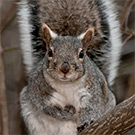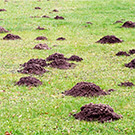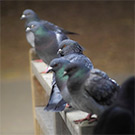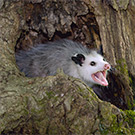Mice Treatment- Prep & What to Expect
If you're hearing or seeing rodent activity, it's time to call a professional. Find an overview of what to do and what to expect here.
[MORE]Dewey Pest & Wildlife is a Massachusetts licensed Problem Animal Control Agent specializing in exclusion, trapping, humane removal, and chimney caps. We offer a one to two year guarantee on all our exclusion work along with the option to renew once the guarantee has expired. We work to rid your home of nuisance wildlife in the most humane way possible.
Here is a list of nuisance wildlife we service for:

Bats are very beneficial to our environment, are protected by law and must not be killed as a form of control. Unfortunately bats also carry rabies and many other ectoparasites that can be harmful to people. Dewey Pest & Wildlife can safely remove bats from your home or business and provide bat proofing to prevent further infestations. If a bat is in your home, confine the bat in a room and call us. In a situation where a bat has entered a bedroom, call the MDPH at 617 983-6800 (24hrs). Because a bat’s teeth and claws are so small, it’s impossible to determine whether someone has been bitten. Therefore, it’s up to the MDPH to determine whether you or your child should receive post-exposure prophylaxis (PEP) shots.

Flying Squirrels are nocturnal (active at night) and do not actually fly but glide through the air. They are the size of a chipmunk and can easily enter very small holes to gain entrance to your house. They are sociable and gentle but very gregarious in the winter.

Gray Squirrels have the distinction of being the most common nuisance animal in Massachusetts. They do millions of dollars’ worth of damage to homes and businesses each year. The most common entry point, usually by accident, is down the chimney. After falling down the chimney they can end up running around the basement or whatever room contains the oil or gas burner. If the squirrels come down the fireplace and the damper is open they can run around in your house and chew window moldings or door casings when trying to escape. To help prevent this, we recommend that every chimney be capped with a stainless steel rain/animal guard. We install stainless steel caps and offer a lifetime warranty on the materials and installation.

Moles are small mammals that spend most of their lives in underground burrows. They are seldom seen by humans. When seen, they frequently are mistaken for mice or shrews. The most conspicuous features of the mole are its greatly enlarged, paddle-like forefeet and prominent toenails, which enable it to “swim” through the soil. They lack external ears, and their eyes are so small that at first glance they appear to be missing. Moles prefer moist, sandy loam soils in lawns, gardens, pastures and woodlands, and generally avoid heavy, dry clay soils. They construct extensive underground passageways. Mole activity in lawns or fields usually appears as ridges of upheaved soil. Burrowing activity occurs year-round but peaks during warm, wet months. The ridges of their tunnels make lawn mowing difficult. Since the roots are disturbed, grass may turn brown and unsightly. Moles rarely eat flower bulbs, ornamentals or other vegetative material while tunneling, but plants may be physically disturbed as moles tunnel in search of animal organisms in the soil.

Nuisance Birds such as pigeons, starlings, and sparrows can cause expensive damage to your home or business. Their nests can clog drains and pipes and their droppings can deface buildings, sidewalks, awnings and outdoor furniture. Dewey Pest & Wildlife will customize a plan to rid birds from your property. The plan may include netting, spikes, bird wire, gel, and mechanical exclusions. We also use expert bird repellant products such as Nixalite, Bird-B-Gone, and Hotfoot.

Opossum are small to medium-sized marsupials, with the largest just exceeding the size of a large house cat and the smallest the size of a small mouse. They are usually solitary and nomadic, staying in one area as long as food and water are easily available. Some families will group together in ready-made burrows or even under houses or in attics. Opossums like to eat garbage, fruit, vegetables, green plants, snails, slugs, snakes, and insects.

Raccoons are predominately nocturnal but may be seen during the daylight hours. If you see one out during the day it does not mean that the animal is sick. But if it’s acting strangely, stumbles, wanders in circles etc. call your local animal control officer or police department. Raccoons are medium sized animals in the 12-20 lbs. range. They are predacious and will eat both animal and plant foods. Raccoons cause significant damage to agricultural crops like fruits and vegetables, they kill poultry, topple trash cans and shred lawns looking for grubs. Raccoons also cause damage to buildings when seeking shelter. They tear open soffits, rip open vents and even remove siding trying to gain entrance. Raccoons have also been known to raise their young in unused fireplaces. Raccoons breed between mid-January and March.

Skunks are about the size of a house cat but have a relatively small head, short legs, robust, wide rear end and bushy tail. Skunks can spray a musky fluid 8-10 ft very acutely when provoked. They like to nest in natural cavities under stone walls and fallen trees but porches and decks are also attractive nesting sites. Skunks do carry the rabies virus so care must be taken when you see a skunk out in the open.

Woodchucks, also known as groundhogs, are one of the largest members of the squirrel family. This highly adaptable mammal commonly inhabits farm fields, idle lands, and suburban neighborhoods. It has a compact, chunky body supported by short, strong legs. Its forefeet have long, curved claws that are adapted for digging ground burrows where it seeks refuge and hibernates during winter months. They have yellowish brown to blackish-brown fur. Woodchucks dig burrows, which they use to bear and raise young and escape from predators. In suburban areas, woodchucks commonly burrow under barns, sheds, and porches. Often woodchucks will take up residence under stone walls, woodpiles, or porches, using several auxiliary dens for shelter. The burrows dug by woodchucks are 8 to 66 feet long and 2 to 5 feet deep. They normally have two or three entrances, although there may be as many as five. The main entrance can be identified by the mound of excavated dirt and stones surrounding the entrance. Woodchucks eat a wide variety of vegetation, including grasses, weed shoots, clover, alfalfa, and soybeans. They will also consume garden vegetables such as cabbage, beans, peas, and carrots and fruits such as apples, cherries, and pears.